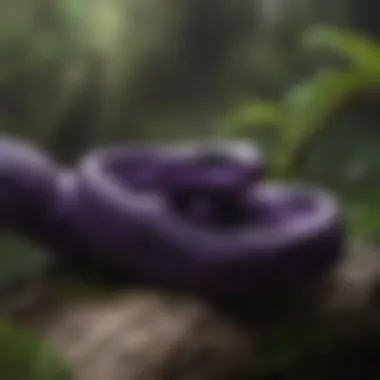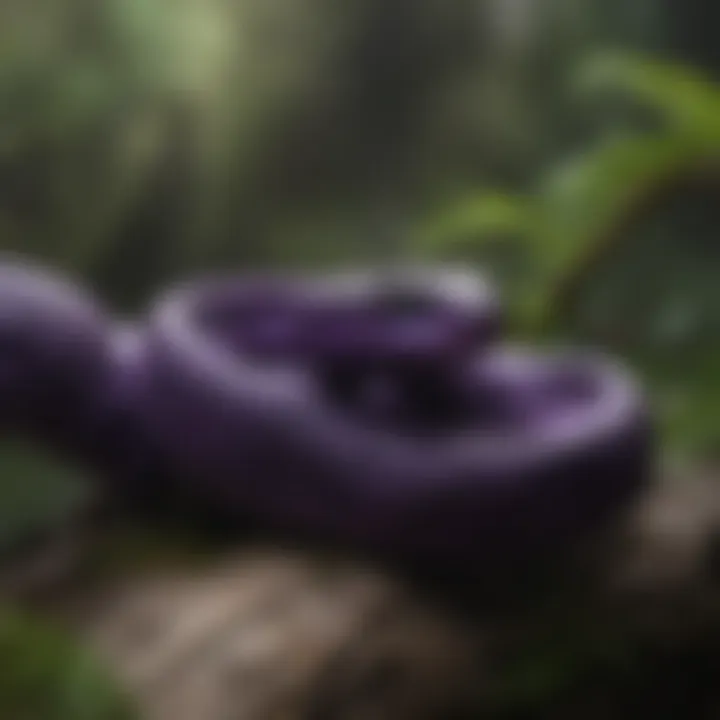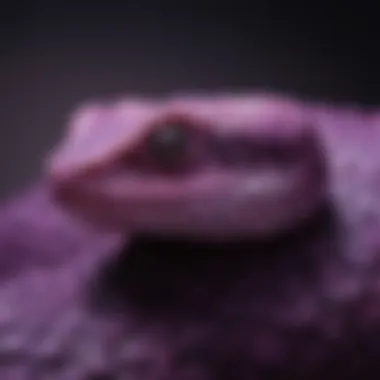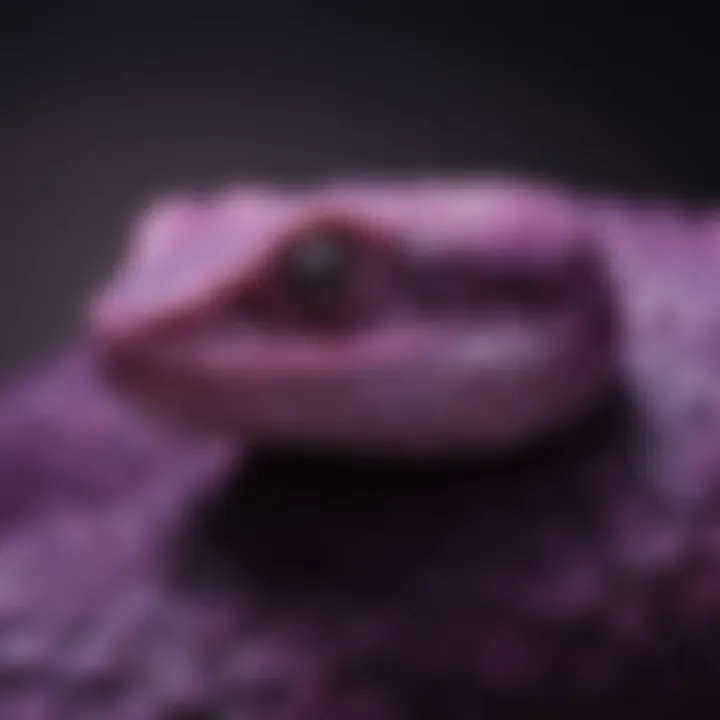Exploring the Mysteries of Black and Purple Pit Vipers


Intro
Black and purple pit vipers are fascinating creatures that inhabit diverse ecosystems. Known for their striking coloration and adaptability, these snakes embody unique biological characteristics that warrant detailed exploration. Their presence in various habitats emphasizes their role in maintaining ecological balance.
This article will guide readers through a systematic examination of these reptiles, uncovering insights into their biology, behavior, and conservation needs. Understanding the intricacies of black and purple pit vipers is essential not only for enthusiasts but also for anyone interested in biodiversity and ecosystem health.
Techniques and Tips
Skill Development
To truly appreciate black and purple pit vipers, one must understand their behavior and habitat preferences. Observing these snakes in the wild requires a keen eye and patience. Familiarity with their seasonal patterns can enhance observation success.
Engaging in herpetology workshops can help individuals cultivate skills in snake identification and behavior study. Developing a comprehensive knowledge base serves as a foundation for conservation efforts.
Practical Techniques
- Field Guides: Utilizing field guides specific to the region can help in identifying black and purple pit vipers effectively.
- Photography: Documenting encounters through photography assists in collecting data for research and awareness efforts.
- Local Networks: Joining local herpetological societies connects individuals with experts who share valuable experiences and insights.
Common Mistakes to Avoid
- Underestimating Risks: Always be aware of the risks associated with interacting with venomous snakes. Misjudgment can lead to serious injuries.
- Ignoring Local Regulations: Familiarizing yourself with the local laws regarding snake observation or capture is vital to ensure compliance and conservation support.
- Failing to Respect Habitats: Invasive behaviors, such as disturbing nests, can disrupt these snakes' natural behaviors and habitat integrity.
Understanding Their Biology
Black and purple pit vipers exhibit remarkable adaptations that enable them to thrive in various environments. Their coloration serves multiple purposes, including camouflage and temperature regulation. Learning about their physical and behavioral traits can enrich one's understanding of these reptiles.
- Coloration and Patterns: The unique patterns provide effective camouflage in their natural settings, helping them avoid predators and enhance hunting capabilities.
- Diet: Their diet primarily consists of small mammals and birds. Understanding their feeding habits reveals how they contribute to the ecosystem.
"These snakes hold significant ecological roles, often acting as indicators of ecosystem health. Their presence reflects the biodiversity and stability of their habitats."
Conservation Challenges
Black and purple pit vipers face numerous threats, ranging from habitat destruction to climate change. Raising awareness about these challenges is crucial for developing conservation strategies.
Key threats include:
- Habitat Loss: Urbanization and deforestation severely impact their natural habitats.
- Poaching: Illegal capture for the exotic pet trade can lead to population declines.
Engagement with conservation organizations and supporting sustainable practices can help mitigate these threats and foster awareness about preserving these unique reptiles.
Intro to Pit Vipers
The discussion of pit vipers sets the foundation for understanding their unique contributions to the environment. These snakes belong to the subfamily Crotalinae, and they are distinguished by their heat-sensing pits located between the eyes and nostrils. In the context of this article, awareness of their defining features is essential. Recognizing pit vipers can enhance appreciation for these creatures and inform conservation efforts.
Defining pit vipers involves understanding not just their physical traits, but their behaviors and adaptations. Each type of pit viper, including black and purple varieties, illustrates incredible evolutionary paths. From their camouflage to their hunting strategies, these adaptions demonstrate their role within the ecosystem.
Observing the significance of pit vipers in various ecosystems provides insight into their ecological roles. They serve as both predators and prey, participating in food webs that sustain broader animal populations. Their presence can indicate a healthy environment, highlighting their importance in ecological balance. Thus, the study of pit vipers also reflects the overall health of their habitats, making their conservation vital for biodiversity.
In this section, we will delve deeper into the definitions and importance of pit vipers, establishing a context for understanding their role in nature and the reasons for their conservation.
Identification of Black and Purple Pit Vipers
Identification of black and purple pit vipers is crucial in understanding their unique biological traits and ecological roles. Accurately distinguishing these species allows researchers and conservationists to monitor populations effectively. The methods for identification are essential as they aid in further studies related to their behavior, habitat, and conservation status. Recognizing these snakes can also help to prevent harmful interactions with humans, ensuring a safer coexistence.
Physical Characteristics
Size and Colour Variations
Black and purple pit vipers exhibit significant size and color variations that are key for identification. The average size of these vipers can vary greatly depending on their species and environment. On average, they measure between 60 to 150 centimeters in length. The distinct colorations, ranging from deep black to vibrant purple, are not only fascinating but serve practical purposes as well.
One notable advantage of size and color variations is their adaptability to different habitats. Darker-colored vipers may thrive better in shaded areas, while those with purple hues may blend well in flower-rich environments. This camouflage is a crucial survival trait, allowing them to ambush prey more efficiently.
Distinctive Patterns


Distinctive patterns on the skin of black and purple pit vipers are another vital identification feature. The patterns can range from simple stripes to complex geometric shapes. These markings are essential for their survival. The unique designs help each snake to blend into its surroundings, making it harder for predators and prey to detect them.
The presence of these patterns can vary widely among individuals. Some exhibit striking contrast between black and purple, while others are more muted. This variability contributes to their camouflage. Understanding these patterns is beneficial in the contexts of species identification and ecological study, as it helps in tracking genetic diversity within populations.
Tail Features
The tail features of black and purple pit vipers provide additional identification clues. The shape and coloration of their tails can vary, with some having broad, flattened tips while others are more slender. This variation plays a role in their hunting and mating behaviors. For example, some species may use their tail for signaling during courtship, while others may rely on it for balance during rapid movements.
Furthermore, the coloration of the tail can indicate the health and maturity of the snake. Typically, a vibrant and well-defined tail color is a sign of a healthy individual. Observing these details contributes to a better understanding of their biology and helps in assessing ecosystem health.
Geographic Distribution
Understanding the geographic distribution of black and purple pit vipers is crucial for appreciating their ecological role, conservation needs, and interaction with other species. The areas where these snakes thrive reveal a lot about their adaptability and the ecosystems they inhabit. Geographic distribution not only informs their behaviors but also helps in identifying potential threats they face due to habitat loss and environmental changes.
Natural Habitats
Black and purple pit vipers are predominantly found in diverse habitats, ranging from humid rainforests to arid mountain ranges. Their preference for specific environments depends on various factors including temperature, humidity, and availability of prey. These snakes are adept at surviving in both tropical and subtropical regions. They typically occupy areas with dense vegetation where they can easily find shade and camouflage against predators.
Key aspects of their habitats include:
- Rainforests: These provide high humidity and shelter, essential for their survival. The dense foliage allows them to ambush prey efficiently.
- High-altitude Zones: Some populations can be found in cooler mountain regions. Here, they adapt by varying their diet to suit available species.
- Wetlands: Areas with swampy terrain are also favorable due to the abundant small mammals and amphibians present.
Range and Population Density
The range of black and purple pit vipers is geographically limited yet significant. Generally, these snakes can be found in regions across Southeast Asia, but specific populations may exist in isolated pockets that impact their genetic diversity. Population density varies significantly, influenced by local environmental conditions and human activities.
Key points regarding their range and population density include:
- Population Centers: Vast populations can often be found in untouched areas with rich biodiversity, while over-developed regions tend to have sparse snake populations.
- Threatened Areas: In regions affected by deforestation or pollution, such as parts of Indonesia, population numbers have dwindled to alarming levels.
- Conservation Zones: Protected areas tend to show healthier population densities due to limited human interference.
"A diverse range ensures healthier ecosystems; the loss of these snakes could mean instability in their respective habitats."
In summary, the geographic distribution of black and purple pit vipers is a testament to their adaptability and ecological importance. Understanding where they live helps focus efforts on their conservation and the protection of their habitats.
Behavioral Patterns
Understanding the behavioral patterns of black and purple pit vipers is essential for comprehending their survival and ecological roles. The behaviors observed in these snakes offer insights into their interactions with the environment, other species, and their own species. Each behavior serves a purpose, whether in hunting, mating, or habitat selection, and is shaped by evolutionary pressures.
Reproduction and Lifecycle
The reproductive behaviors of black and purple pit vipers are integral to their population sustainability. These snakes follow a specific mating season, often influenced by environmental factors such as temperature and prey availability. Mating usually occurs in late spring, where males engage in competitive displays to attract females.
Females are ovoviviparous, meaning they give birth to live young rather than laying eggs. This trait is crucial in colder climates as it allows the young snakes to be born in a more favorable condition. The gestation period can vary, but it typically lasts several months. After birth, the young are independent and must immediately learn to hunt and avoid predators. This independence is crucial for the survival of the species. The survival rate of hatchlings is low, primarily due to predation.
Feeding Habits
Feeding is a vital aspect of the life of black and purple pit vipers. Their diet mainly consists of small mammals, birds, and sometimes amphibians. The hunting strategy is largely ambush-based, where these vipers rely on their camouflage to blend in with their environment, waiting silently until prey comes close.
Once an opportunity arises, pit vipers use their heat-sensing pits to detect warm-blooded prey even in low light. Their venom is crucial for subduing prey, allowing them to immobilize and digest their meals. The frequency of feeding can vary based on the size of the prey and the individual snake's metabolism.
Furthermore, it’s important to note that during colder months, these snakes may reduce their feeding significantly, entering a state of brumation, where their metabolic activities slow down. This evolutionary adaptation ensures they conserve energy while food becomes scarce.
Understanding these behavioral patterns provides critical information for conservation efforts, as alterations in behavior can indicate changes to their habitat or health, necessitating intervention.
Venom Composition and Effects
The study of venom in black and purple pit vipers reveals essential insights that reach beyond mere curiosity. It helps us understand these snakes' predatory strategies, roles in their ecosystems, and implications for medical science. Venom is not only a tool for hunting but also a means of defense. Knowing its composition enables researchers to explore applications in medicine and antivenom development, which are critical for addressing snakebite morbidity.
Types of Venom
Black and purple pit vipers possess a varied venom composition, adapted for their ecological niches. The primary types of venom include:
- Hemotoxic Venom: This venom affects tissues and the circulatory system. It can damage blood cells and disrupt clotting processes. Such venom allows the snake to incapacitate larger prey rapidly.
- Neurotoxic Venom: Though less common in these species, certain pit vipers produce neurotoxic components that can interfere with the nervous system. This type of venom can lead to paralysis, hindering both movement and defense of the prey.
"Understanding venom types not only informs wildlife biologists but also contributes to antivenom education and production."


Medical Significance
The medical relevance of pit viper venom cannot be overstated. The bioactive compounds found in the venom are of great interest in pharmacological research. Here are some important points regarding its medical significance:
- Antivenom Production: Venom is a crucial source for developing effective antivenoms. The composition of venom varies among species, impacting the efficacy of treatments.
- Drug Development: Certain proteins in the venom can lead to breakthroughs in pain management, hypertension treatment, or blood clotting disorders. For instance, compounds derived from venom have shown potential in creating new analgesics far stronger than traditional painkillers.
- Ecosystem Health Indicator: The vitality of pit viper populations and their venom composition can indicate overall ecosystem health. This serves as a reminder of the intertwined relationships within biodiversity.
Understanding the venom composition is not merely academic. It stresses the points around conservation, emphasizing the need to protect these reptiles and their habitats. The future of medical advancements could hinge on preserving such species.
Conservation Status
The conservation status of black and purple pit vipers is a crucial aspect that reflects not only the health of their populations but also the overall state of the ecosystems they inhabit. Understanding these factors is essential for implementing effective conservation measures. As with many species, the survival of these vipers is linked to their habitats, which are increasingly under threat.
Addressing conservation status also helps raise awareness among the public about the importance of maintaining biodiversity. This awareness can lead to positive changes in behaviors and policies, which ultimately benefit both the species and the environment they depend on.
Threats to Habitat
Deforestation
Deforestation poses a significant threat to black and purple pit vipers. This practice involves the large-scale removal of trees and vegetation, which directly impacts the habitats where these snakes thrive. The main reason for deforestation includes agricultural expansion, logging, and urban development. These activities fragment habitats and reduce food sources for pit vipers, making survival increasingly difficult.
A key characteristic of deforestation is its rapid pace. Areas that were once lush forests can be cleared in a short time, leaving behind barren landscapes. This transformation is alarming, particularly as it leads to considerable biodiversity loss. For this article, understanding deforestation is beneficial because it illustrates the urgency of protecting these habitats. A unique feature of deforestation is its long-lasting impact on local ecosystems, which can take decades or even centuries to recover, if they recover at all.
Pollution
Pollution is another critical threat to the habitats of black and purple pit vipers. Different types of pollution, including chemical runoff from agriculture and waste products from urban areas, contaminate the environments where these snakes live. This not only affects the pit vipers' health but also their food sources.
The key characteristic of pollution is its pervasive nature. It drifts into wetlands, rivers, and forests, influencing ecosystems far beyond the immediate area of contamination. Pollution is a relevant topic for this article as it highlights the interconnectedness of environmental issues. A significant downside of pollution is that it often goes unnoticed until substantial damage has already occurred, making it imperative for audiences to understand its scope and effects.
Conservation Efforts
Various conservation efforts are currently underway to protect black and purple pit vipers and their habitats. These programs focus on habitat preservation, public education, and legislation aimed at reducing threats. Collaborations between governments, NGOs, and local communities are increasingly important for the success of these efforts.
Education is also an essential component. Raising awareness about the ecological role of pit vipers and the dangers they face can inspire action. Additionally, implementing sustainable practices in agriculture and urban planning can help mitigate some of the negative impacts on their habitats.
In summary, conservation status is a critical element in understanding the plight of black and purple pit vipers. Addressing threats like deforestation and pollution is vital, as well as fostering conservation initiatives that can help ensure their survival.
Cultural Significance
The cultural significance of black and purple pit vipers extends beyond mere existence; it intertwines with human traditions, beliefs, and artistic expressions across various societies. These reptiles have captured attention not only for their distinct characteristics but also for the rich narratives they inspire. Understanding their role in culture can provide insights into how societies perceive nature, fear, respect, and even revulsion towards these unique creatures.
Symbolism in Various Cultures
In numerous cultures, the black and purple pit viper has been regarded as a symbol of various traits. In some traditions, they embody strength and resilience. For many indigenous tribes, these snakes are viewed as guardians of the earth, representing the balance of nature. Their capacity to thrive in different environments serves as a reminder of adaptability—a theme often celebrated in folklore.
Conversely, in some societies, the same snakes are seen as harbingers of danger or bad luck. The deep colors of black and purple can evoke fear or caution, leading to their portrayal as sinister entities in tales. This juxtaposition of perceptions highlights a multifaceted relationship humans have with these reptiles, reflecting both admiration and fear.
Other cultures integrate these snakes into mythology, attributing them with supernatural abilities or linking them closely with deities. For example, in certain Asian cultures, snakes are seen as symbols of rebirth and transformation, owing to their shedding skin. This association fosters a deeper appreciation of life cycles and the natural world itself.
Misconceptions and Folklore
Misconceptions about black and purple pit vipers often arise due to their appearance and reputation. Many people assume that all venomous snakes are aggressive, which is not accurate. These pit vipers, while capable of defending themselves when threatened, often prefer to avoid confrontation. Such misunderstandings can lead to unwarranted fear and persecution.
Folklore has also propagated myths that can skew public perception. Many tales exaggerate the venom potency of these vipers, causing irrational fears, especially among rural communities. Misrepresentation in media further complicates public understanding, as sensationalized portrayals of these snakes may lead to confusion and disregard for their ecological role.
Efforts to dispel these myths rely heavily on education and awareness. Highlighting the importance of black and purple pit vipers in their ecosystems helps counteract negative perceptions. They play a crucial role in controlling rodent populations, contributing to biodiversity. Recognizing their ecological significance allows for a re-evaluation of the narratives surrounding them, fostering respect rather than fear.
"Cultural narratives shape our understanding of wildlife, often merging reality with myth. Black and purple pit vipers exemplify this complex relationship."
Research and Studies
Research and studies related to black and purple pit vipers are vital for understanding these unique reptiles. They provide insights into their behavior, ecology, and health. By gathering data from different aspects of their lives, researchers can better assess their role in the environment and the effects of human activities. This knowledge is essential for developing effective conservation strategies.
Field studies and laboratory research help scientists gather empirical evidence. These two types of research complement each other, offering a comprehensive view of the dynamics involved in the life of pit vipers. Their findings impact both scientific communities and public awareness.


Field Research
Field research focuses on observing black and purple pit vipers in their natural habitats. Scientists use various methods to collect data on their behaviors, diets, and interactions within ecosystems. It allows researchers to gather real-time information that can be hard to replicate in controlled environments.
Several important elements are considered in field research:
- Habitat Analysis: Understanding the environments these snakes inhabit helps identify critical areas for conservation.
- Behavioral Observations: Monitoring their activity patterns informs about their daily lives and environmental adaptations.
- Population Tracking: Assessing population sizes and ranges helps gauge the health of species.
The benefits of field research are clear. It provides a foundation upon which effective conservation policies can be built. Furthermore, it promotes a direct connection with the natural world, encouraging appreciation and awareness among communities.
Laboratory Studies
Laboratory studies bring a different dimension to our understanding of black and purple pit vipers. In a controlled setting, researchers can study specific aspects of their biology that are hard to observe in the wild.
Key components of laboratory studies include:
- Venom Analysis: Understanding the composition and effects of their venom can lead to medical advancements.
- Genetic Studies: Researching their genetic makeup may provide insights into biodiversity and evolution within pit vipers.
- Health Assessments: Monitoring the health of captive snakes can reveal important information about their welfare and conservation status.
Laboratory findings contribute significantly to the overall body of knowledge. They can confirm hypotheses developed during field studies or present new avenues for inquiries.
The combination of field and laboratory efforts creates a holistic understanding of black and purple pit vipers, ultimately informing effective conservation and management strategies.
Public Awareness and Education
Public understanding is critical in the conservation and appreciation of black and purple pit vipers. Highlighting their importance aids in dispelling fears and misconceptions surrounding these snakes. This educational focus can foster respect for their role in the ecosystem and encourage active measures for their protection.
Raising awareness also serves to inform communities about the ecological benefits that pit vipers provide. As predators, they help control rodent populations, which can lead to a healthier balance in local ecosystems. When communities realize the importance of biodiversity, they are more likely to support conservation initiatives.
Furthermore, education about features unique to black and purple pit vipers can help individuals distinguish them from other snake species. Knowledge reduces fear and leads to safer interactions between humans and wildlife. By concentrating on awareness campaigns and educational resources, we can create informed advocates for these reptiles.
Importance of Awareness Campaigns
Awareness campaigns play a vital part in conservation efforts. They can be aimed at various audiences, from local communities to global audiences. Such campaigns often focus on specific threats these snakes face, such as habitat loss or illegal trade.
Through social media platforms, local workshops, and educational seminars, people can learn how to recognize and protect these snakes. For example, initiatives might involve:
- Community Engagement: Organizing local events to teach people about their local biodiversity.
- Digital Campaigns: Using platforms like Facebook and Reddit to share information with a wider audience.
- Collaboration with Wildlife Experts: Partnering with scientists and conservationists to create informative materials.
"Awareness is the first step towards active participation in conservation efforts."
Promoting these campaigns can substantially shift public perception and inspire action, leading to stronger conservation measures at local, national, and international levels.
Educational Resources
To effectively educate the public about black and purple pit vipers, several resources can be utilized. These resources should be accessible and informative, catering to different learning styles. Some suggested resources include:
- Websites: Sources like Britannica or Wikipedia can provide comprehensive information about pit vipers’ ecology and physiology.
- Documentaries: Visual storytelling can reach wider audiences. Documentaries about snakes can spark interest and provide eye-opening facts.
- Local Libraries: Titles on herpetology and snake conservation can give readers in-depth understanding and often come recommended by educators.
In addition, schools can integrate information about reptiles into science curricula. This instills appreciation for wildlife from a young age. Educational partnerships between schools and conservation organizations can also provide hands-on learning experiences such as field trips.
By making these resources available, we can nurture a generation that values and advocates for the protection of black and purple pit vipers and their habitats.
End
The conclusion serves as an essential component of this article, encapsulating the discussion surrounding black and purple pit vipers. In it, we reiterate the importance of understanding these elusive creatures, their ecological roles, and the challenges they face. This section synthesizes key insights from previous sections, thereby reinforcing the interconnectedness of the various elements discussed.
Summary of Key Points
The article encompasses several critical points:
- Habitats and Geographic Distribution: Black and purple pit vipers inhabit diverse environments, highlighting their adaptability.
- Behavioral Patterns: Their reproductive habits and feeding behaviors demonstrate their survival strategies within their ecosystems.
- Venom Composition: Understanding the types of venom not only aids in recognizing their ecological significance but also underscores their potential medical benefits.
- Conservation Status: The threats posed by pollution and habitat destruction call for targeted conservation efforts to preserve these species.
This summary encapsulates the main themes and findings discussed, providing a foundation for future exploration and understanding of these reptiles.
The Future of Pit Vipers
Looking ahead, the future of black and purple pit vipers appears uncertain due to ongoing environmental changes. Effective conservation efforts remain paramount. Future strategies must involve habitat preservation and enhanced public education about these snakes to alleviate fears and promote coexistence.
Research initiatives should continue to expand our knowledge about their ecology and behavior. By fostering appreciation for their role in the ecosystem, we can advocate for more robust policies aimed at their protection. The collaboration between scientists, conservationists, and local communities will be key in ensuring the survival of these unique reptiles.
It's imperative to maintain a vigilant approach to ensure the longevity of black and purple pit vipers and their habitats. By combining awareness with action, we can safeguard their future.







